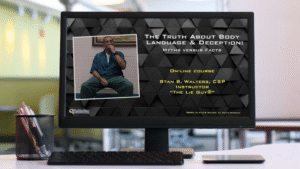Interview and Interrogation Techniques:
The Truth About Body Language and Deception

Everyone has a theory about body cues and deception— but most of them are dead wrong.
In this course, we separate myth from reality and give you practical tools backed by research.
Understanding body language and deception requires more than instinct — it demands research and repeatable technique.
Learn what body language actually reveals — and what it doesn’t — so you can avoid critical mistakes and stay focused on the facts.
Why Body Language Alone Isn’t Enough
It’s easy to fall for nonverbal deception myths — they’re everywhere. But peer-reviewed research shows that trying to detect deception based solely on body language is only 54% accurate. That’s no better than flipping a coin.
In real-world interviews, relying on myths like eye aversion or fidgeting can lead to false assumptions, confirmation bias, and even wrongful accusations. That’s why this course is built on evidence — not folklore.
3 Nonverbal Cues Myths That Can Mislead You
-
Eye Aversion = Deception
Truthful people often look away while thinking. Skilled liars may lock eyes to appear confident. Eye contact alone means nothing without context. -
Crossed Arms = Defensiveness
This posture is often misread. People cross their arms for warmth, comfort, or habit — not necessarily because they’re hiding something. -
Face Touching, Fidgeting, or Grooming = Guilt
Touching the mouth, scratching the nose, or adjusting clothing are normal stress behaviors seen in honest and deceptive people alike. They’re not reliable indicators of deception.
👉 Real deception detection goes deeper than body language — and this course shows you how to do it right.
What You Will Learn
- Why most body language “rules” lead to false assumptions.
- What the science really says about deception and movement.
- Key nonverbal signals that support — not replace — verbal content.
- How context and baseline behavior shape interpretation.
- How to avoid the “junk science” trap in court or on the stand.
Why It Matters
Body language myths are everywhere — in pop culture, on YouTube, even in some police training rooms.
Relying on outdated or debunked cues doesn’t just weaken your case — it can destroy your credibility.
This course gives you the tools to separate science from speculation so your analysis holds up in the real world — and in court.
Who Should Register
- Investigators who want to avoid false reads and bad assumptions.
- Law enforcement professionals looking to update outdated training.
- Fire, arson, and fraud investigators who rely on nonverbal cues.
- HR and security interviewers seeking fact-based assessment tools.
- Anyone who testifies in court and needs their methods to hold up.
What happens in the interview room echoes in the courtroom.®
